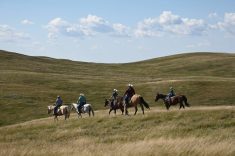We keep records to help us make management decisions with both cattle and horses. They help us to make good breeding or culling decisions, and on occasion they make for a good laugh.
While going through the records recently, I discovered a funny coincidence. In the 2020 calving records I had recorded how I went out to check calving cows at about 4:00 a.m. I found a second-calf heifer had calved and so I got the sled and put her and her calf in the calving pen under the infrared heater. It was about -20 C.
The calf was very fresh so I decided to help dry the ears off. I left the corral to get a towel, and when I got back the cow had one calf on her right and a second one on her left. She licked one and then turned and licked the other. Twins! She had everything under control so I left her alone. When I recorded the twins in the calving book, Gregory and I had a little chuckle, as it was April Fools Day.
Read Also

Harvest wraps up and fall work begins
At the Eppich famly ranch in western Saskatchewan, the fall harvest was successful with few breakdowns, cows and calves have been sorted and a new tractor has arrived
The real laugh came two years later. We found a first-calf heifer in labour. We put her in a calving pen and when we checked her a little later, we discovered she had twins. I recorded the birth in the calving book and chuckled about it being April l. That made me think, and so I went back in the records and discovered that not only did we have a set of twins on the April 1, 2020 and 2022, but that the cows were related. The cow that had the twins in 2020 was the mother of the heifer that had the twins in 2022! So, is this a family trait we should come to expect?
Horse records
Another funny coincidence began to emerge in the horse records. Gregory and I bought an open brood mare in the fall of 2018. In 2019 we bred her to our stallion. She had had many foals before but the first for us was born May 11, 2020. In fact, for three years in a row, from 2020 to 2022, she foaled on May 11 each year.
The approximate due date for the mare was different every year, yet she foaled on the same day. Not only did she have a foal on the same day for three years in a row, she had a grey stud colt three years in a row. In horses the grey gene is dominant, which means if they have the gene they are or will become grey as they get older. I had the mare tested and she only has one copy of the grey gene, which means that there is only a 50 per cent chance of the foal being grey.
Just like in people, the gender of the offspring is determined by the sire. A female is an XX while a male is an XY. The mare could only pass on her X copy, while the stallion could pass either the X or the Y. This makes it so there is only a 50 per cent probability of getting a stud colt.
In 2021, we bred the mare to a different stallion. Even with this change which would have had no affect on the grey gene, but would have had the potential to affect the gender and the gestation length, the old mare did it again. On May 11, 2022 she had a grey stud colt. So, what will she do this in 2023?
















